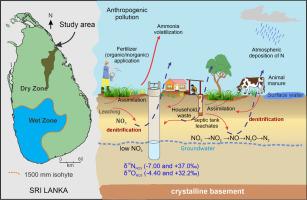当前位置:
X-MOL 学术
›
Water Res.
›
论文详情
Our official English website, www.x-mol.net, welcomes your
feedback! (Note: you will need to create a separate account there.)
Sources and dynamics of nitrate in groundwater in a crystalline terrain of tropical Sri Lanka based on a dual isotope approach
Water Research ( IF 11.4 ) Pub Date : 2025-05-27 , DOI: 10.1016/j.watres.2025.123914
Charitha Udeshani, Fu-Jun Yue, Yao-Qi Gong, Si-Liang Li, Rohana Chandrajith
Water Research ( IF 11.4 ) Pub Date : 2025-05-27 , DOI: 10.1016/j.watres.2025.123914
Charitha Udeshani, Fu-Jun Yue, Yao-Qi Gong, Si-Liang Li, Rohana Chandrajith

|
Nitrate pollution of groundwater is one of the major environmental problems in many parts of the world, mainly due to intensive agriculture and waste disposal. Therefore, understanding the fate of nitrate in aquifer systems is important for sustainable groundwater management. In Sri Lanka, a tropical terrain largely covered by high-grade metamorphic rocks, non-point source pollutants from agricultural lands are the main sources of nitrate in groundwater. This study presents nitrate dual-isotope signatures (δ15 NNO3 and δ18 ONO3 ) of groundwater samples collected during the pre- (n = 60) and post-monsoon (n = 71) periods from the Yan Oya River basin in the dry zone of Sri Lanka. The nitrate concentrations (as NO3 - -N) of the groundwater samples varied between 0.10 and 5.60 mg/L. The δ15 NNO3 and δ18 ONO3 values were between -7.0 and +37.0 ‰ and between -4.4 and +32.2 ‰, respectively. The large coefficient of variation (CV) values (>100 %) of nitrate concentrations indicated higher spatial variability and the influence of non-point source pollutants on groundwater nitrate concentrations. Land use was the primary factor influencing spatial heterogeneity. The isotopic evidence demonstrated that nitrate in groundwater originated through nitrification and mixing of sources, e.g., manure, sewage, soil nitrogen, and ammonium in fertilizer. The fractionation during nitrate transformation processes and mixing of sources have altered the nitrate isotopic signatures of the sources in the region. Denitrification, assimilation, and ammonia volatilization reduced available nitrate for leaching in soil, resulting in lower nitrate concentrations with higher isotopic values in groundwater. The present study highlights the importance of applying dual isotopes to identify the sources and fate of groundwater nitrate in a crystalline aquifer in the dry zone of Sri Lanka.
中文翻译:

基于双同位素方法的斯里兰卡热带结晶地形地下水中硝酸盐的来源和动力学
地下水的硝酸盐污染是世界许多地方的主要环境问题之一,主要是由于集约化农业和废物处理造成的。因此,了解硝酸盐在含水层系统中的归宿对于可持续的地下水管理非常重要。斯里兰卡是一个主要被高品位变质岩覆盖的热带地形,来自农田的非点源污染物是地下水中硝酸盐的主要来源。本研究展示了在季风前 (n = 60) 和季风后 (n = 71) 期间从斯里兰卡干旱区的 Yan Oya 河流域收集的地下水样本的硝酸盐双同位素特征(δ15NNO3 和 δ18ONO3)。地下水样品的硝酸盐浓度(以 NO3--N 计)在 0.10 至 5.60 mg/L 之间变化。δ15NNO3 和 δ18ONO3 值分别在 -7.0 和 +37.0 ‰ 之间和 -4.4 和 +32.2 ‰ 之间。硝酸盐浓度的较大变异系数 (CV) 值 (>100 %) 表明较高的空间可变性和非点源污染物对地下水硝酸盐浓度的影响。土地利用是影响空间异质性的主要因素。同位素证据表明,地下水中的硝酸盐是通过硝化作用和混合来源产生的,例如粪便、污水、土壤氮和肥料中的铵态氮。硝酸盐转化过程中的分馏和来源的混合改变了该地区来源的硝酸盐同位素特征。反硝化、同化和氨挥发减少了土壤中用于浸出的可用硝酸盐,导致地下水中硝酸盐浓度较低,同位素值较高。 本研究强调了应用双同位素来确定斯里兰卡干旱地区结晶含水层中地下水硝酸盐的来源和归宿的重要性。
更新日期:2025-05-27
中文翻译:

基于双同位素方法的斯里兰卡热带结晶地形地下水中硝酸盐的来源和动力学
地下水的硝酸盐污染是世界许多地方的主要环境问题之一,主要是由于集约化农业和废物处理造成的。因此,了解硝酸盐在含水层系统中的归宿对于可持续的地下水管理非常重要。斯里兰卡是一个主要被高品位变质岩覆盖的热带地形,来自农田的非点源污染物是地下水中硝酸盐的主要来源。本研究展示了在季风前 (n = 60) 和季风后 (n = 71) 期间从斯里兰卡干旱区的 Yan Oya 河流域收集的地下水样本的硝酸盐双同位素特征(δ15NNO3 和 δ18ONO3)。地下水样品的硝酸盐浓度(以 NO3--N 计)在 0.10 至 5.60 mg/L 之间变化。δ15NNO3 和 δ18ONO3 值分别在 -7.0 和 +37.0 ‰ 之间和 -4.4 和 +32.2 ‰ 之间。硝酸盐浓度的较大变异系数 (CV) 值 (>100 %) 表明较高的空间可变性和非点源污染物对地下水硝酸盐浓度的影响。土地利用是影响空间异质性的主要因素。同位素证据表明,地下水中的硝酸盐是通过硝化作用和混合来源产生的,例如粪便、污水、土壤氮和肥料中的铵态氮。硝酸盐转化过程中的分馏和来源的混合改变了该地区来源的硝酸盐同位素特征。反硝化、同化和氨挥发减少了土壤中用于浸出的可用硝酸盐,导致地下水中硝酸盐浓度较低,同位素值较高。 本研究强调了应用双同位素来确定斯里兰卡干旱地区结晶含水层中地下水硝酸盐的来源和归宿的重要性。


















































 京公网安备 11010802027423号
京公网安备 11010802027423号